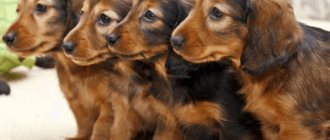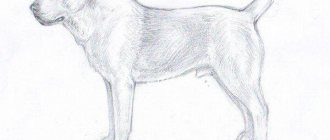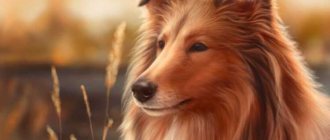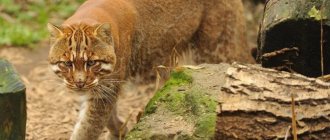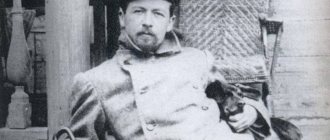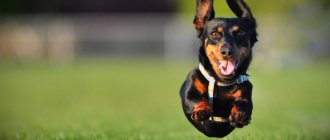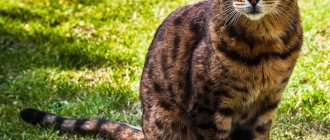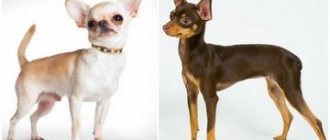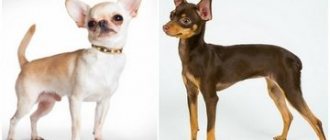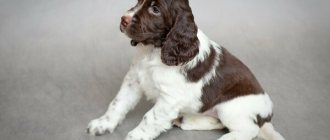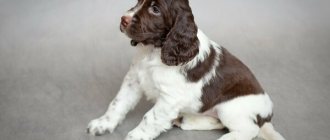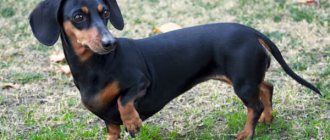Standard and prohibited dachshund colors. Description of permitted options in detail. Colors of wire-haired dogs.
The dachshund quickly follows the animal. Her instinct leads to holes where a fox, badger or rabbit is hiding. Under the ground, the dog overtakes the prey and tries to make a strong grip.
The jaws tighten, but if the animal manages to escape, then a hunter is waiting for it at the top. Dwarf and rabbit dachshunds are able to work together, deftly maneuvering in a narrow hole.
Dachshunds are prized for their fearlessness, determination, and intelligence. It was their independent decision-making that made them successful hunters. The unusual body and proportions also played a significant role in the formation of the breed.
Today, not all dachshunds hunt. There are bright representatives of the exhibition world, they win at international events in rings with other breeds.
Dachshund color standard according to RKF
The Russian Canine Federation has officially recognized the following colors for all types of dachshunds:
- brown and tan;
- redhead;
- black and tan;
- brindle;
- marble based on brown or black.
Boar coloring is allowed only for wire-haired dachshunds.
Fans of the breed know that there are also officially unrecognized colors, for example, sable or isabella. They are rare, but are of growing interest among hobbyists.
Purpose
Dachshunds are hunting dogs designed to hunt foxes and hares, as well as burrow-dwelling beavers, badgers and otters. Among hunting dogs, dachshunds are the smallest, but the most courageous and confident. Since ancient times, many hunters are satisfied with the choice of the smartest breed of dachshund dog. Climbing into a hole, the dachshund fights in a dark and narrow hole, relying only on itself, knowing that the owner will not be able to help. It is also common for dachshunds to hold prey in a hole until the owner opens the hole.
Briefly about the breed
The Dachshund is a short-legged, muscular and squat dog whose size is based on proportions. Thus, the body length of a thoroughbred animal should be 1.7 to 1 to its height, and the distance from the bottom of the chest to the support should be 1/3 of the height.
Different types of breeds, long bred for hunting animals of different sizes, have their own dimensions:The standard type of dog is the largest and most versatile, used for burrow hunting and chasing large animals. Its dimensions are characterized by a height of about 35 cm, a sternum girth of more than 30 cm and a weight of up to 9 kg.
Miniature or dwarf dachshunds occupy a middle position, with a height and rib girth of up to 35 cm, and a weight of 3 to 4 kg. Dwarfs were bred from the stockiest animals of the standard species.
The shortest among the dachshunds is called the rabbit dachshund and is 5 cm shorter than its average counterpart in height and 1 kg less in weight.To obtain a more compact and nimble hound, the dog was crossed with pinschers and toy terriers and used in hunting hares and rabbits.
The standards also spell out body features: a wedge-shaped head, a flat, wide forehead and a flattened nose, oval eyes of dark brown and lightened shades, ears broken in the lower third, a long neck and a saber-shaped low tail.
Colors of dachshund varieties
The permitted colors are relevant for all sizes of dachshunds - the RKF has approved a single breed standard for color.
The only difference in possible coat color is allowed for wire-haired dachshunds of any size: they are allowed boar color, which is a defect in representatives of the breed with a different type of coat.
It can only be noted that fans of the dwarf variety show increased interest in complex and unusual coat colors. This is understandable, because the main value of a mini-dachshund is its decorativeness, and not its performance characteristics.
Character
The character of the marbled dachshund is no different from other types of dachshunds. Remember that they are independent individuals with individual characters. Dachshunds are cheerful dogs, always very playful and positive. They are not aggressive towards children, provided that they do not offend them.
They are distinguished by their authority among other, even large, dog breeds. Fun hunters, fast, trainable and independent dogs. They are always friendly, protect their owner, and are fearless in fights. Elephants become depressed due to lack of attention from their owners and may howl alone.
Crossbreeds and mestizos
Mixed breeds are dogs obtained by crossing different breeds. Dachshund crosses are always somewhat similar in appearance. One of the most common dachshund mixes. The following is a description and photo of dachshund crosses and hybrids.
With a spaniel
Spaniel crosses are more similar in appearance to spaniels. However, their body is slightly elongated, and their character is explosive.
With Jack Russell
This large dog is reminiscent of a Jack Russell in color and has an elongated body. The animal is very active, becomes attached to its owner and gets bored when alone.
With Spitz
In its “dimensions” the dog is more similar to its oblong parent, and in its fur it is more like a Spitz. Spitz crossbreeds have a strong sense of self-esteem and are very stubborn. And they are also quite difficult to teach anything.
With a beagle
Externally, the beagle hybrid is harmoniously built, the body is slightly elongated, the paws are of medium height. Such dogs are smooth-haired, and their character is good-natured and flexible. Very active, love walks.
Among the many varieties of colors, as well as several subspecies of the breed, you are sure to find an animal that suits you not only in appearance, but also in character. By clearly imagining what exactly you want to see in a four-legged pet, you will find in him a faithful companion and devoted friend.
Popular colors
Dachshund colors are divided into three main groups:
Plain
The most popular solid coat color for dogs. The standard describes the colors red, fawn and tan. An even coat tone is preferred on all parts of the body (red is considered the most valuable), but areas with a greater or lesser density of black hairs are acceptable. The presence of white is not acceptable, but minor white spots or hairs are acceptable and will not disqualify the dog. The nose, like the dog’s claws, is most often black, but reddish-brown shades are acceptable.
Two-color
Classic dachshund color. Its base is intense brown or black. The color of the tan marks can range from light sand to intense red and contrast with the main tone. The border between the base color and tan cannot be uneven or blurred.
Scorches can only be located in strictly permissible places:
- underlip;
- muzzle on the sides;
- brows;
- inner part of the ear;
- breast;
- around the anus;
- legs from the inside.
The color of the nose should match the base color of the coat. Small white spots are not approved, but the dog is not rejected.
Difficult
These include brindle or marbled dogs.
The base color of merle dogs is dark (gray, black or tan). Gray and beige spots should not be large and should be randomly located. The brindle color is based on a red or beige background with dark, uneven stripes of different widths, the so-called brindles. The color of the claws and nose is dark.
Dossier
Adult height: standard 20-27 cm, average 14-21 cm, miniature 10-15 cm. Weight: standard 6.5-11.5 kg, average 3.5-5 kg, miniature 3-3.5 kg. Characteristic color: the main color is black, auburn or dark gray with small random gray or beige spots. Coat length: wire-haired, long-haired, smooth-haired. Life expectancy: 15-18 years. Advantages of the breed: intelligent, with an unusual appearance. Difficulties of the breed: stubborn, prone to obesity. Average price of a marbled dachshund: $50-300. Classification: medium, hound, hunting breed.
Advantages and disadvantages
pros:
- Very smart and quick-witted dogs.
- Sweet and funny.
- Movable and energetic.
- They love children and willingly play with them.
- They can protect the house well.
- The black dachshund is an excellent hunting assistant.
- When properly maintained, they rarely get sick and live long enough.
- They look graceful and elegant.
Minuses:
- They may be prone to breed-related ailments, including diseases and injuries of the spine, as well as diseases of the eyes and ears.
- If they are not fed properly, they will quickly become obese.
- They often get into fights with other people's dogs, even if the enemy is much larger and stronger.
- They dig up soil in flower beds and beds, and in apartment conditions they like to turn over flower pots.
- If you allow children to tease your dachshund or pull its tail and ears, it can bite them quite hard.
Like most hunting dogs designed to work independently, black dachshunds are distinguished by great conceit and, at times, excessive independence.
These dogs may refuse to follow their owner's orders, and in this case it can be difficult to redirect them.
Advantages and disadvantages
Pros:
- Unusual appearance.
- Very smart.
- Cute, energetic and cheerful animals.
- They treat children well.
- Live longer than many other breeds.
- Not aggressive towards people.
- Not bad guards.
- Good hunting helpers.
Minuses:
- Predisposed to breed diseases.
- Prone to overeating and obesity.
- They may bark at other people's dogs.
- They can be stubborn.
- They can dig up beds or pots with plants.
Marbled Dachshunds have many virtues, but their instincts often take over. Tell us about similar cases with your pets, how did you cope?
Rare colors
In addition to the extensive list of traditional colors, they now have many unusual coat colors. Many colors are not accepted by the official breed standard, and some are serious defects. Dogs of some coat colors have significant genetically determined problems with immunity and general health.
Brindle and marbled dachshunds are officially recognized.
Unique coat colors include isabella (a mix of cool beige-brown shades), sable (similar to red, but more complex), cream, and grey-tan (cool gray with light brown or sandy tan markings).
The most problematic in terms of health are white dachshunds, especially albinos, and double merles.
Such a variety of appearance allows you to choose a dachshund puppy to suit your taste. If the puppy is chosen as a pet, and not for exhibitions and breeding, then it is not at all necessary to choose a color approved by the breed standard, the main thing is that the puppy is healthy and loved.
Why are albino dachshunds born?
White dachshunds stand out for their appearance; they charm some, and vice versa for others. Sometimes this phenomenon is caused by a genetic failure that is difficult to explain.
White dachshunds sometimes appear in offspring, and the following factors contribute to this:
- Mating of two dachshunds with merle coloring. The likelihood of a genetic failure increases.
- Albinism. Caused by an albino dachshund's body due to a deficiency of a substance called melamine.
- Pure white color of the dachshund, not caused by albinism. It is also called "leucism"
- The minimum number of spots of a different color.
- Maximum bleached cream coat color.
It is very rare to meet a dachshund with a completely white coat color. See photo.
Basic rules of care
Caring for the coat of a black dachshund depends on what type it is..
And, if for smooth-haired pets of this breed regular brushing of the coat is sufficient (twice a week, and during shedding - daily), then long-haired and wire-haired dogs will require special care.
IMPORTANT!
Long-haired dachshunds need a little haircut, and wire-haired ones need special trimming.
While learning how to cut a pet with long hair is easy on your own, trimming a wire-haired dachshund is not so easy and requires special skills.
Therefore, at least for the first time, it is better to entrust the groomer to tidy up the dog, rather than try to trim the dog yourself.
In addition to grooming, all dachshunds require daily eye, ear, and teeth care . If necessary, they are cleaned, and if the claws grow too long, they are trimmed using a special nail clipper, but not nail clippers or scissors.
Popular colors
Ginger
This color is very common among dachshunds. The standard recognizes all possible colors of red, from light beige-gold to dark red with a reddish tint. The most even and bright colors are highly valued. Often there is a red color with muruzina (corresponds to the standard) - black hairs varying in density and intensity.
Brown and tan
Basic brown is combined with tan tones of red. The scorch markings must necessarily contrast with the main background, the saturation of which may differ. Adult dogs should have brown eyes, but some puppies initially have gray or green irises. With age, the eyes become standard brown, so such dogs are not disqualified.
It is very rare to find individuals that appear completely brown. They still have a tan, but it is darkened. This option is not a defect, but is regarded as a disadvantage.
Black and Tan
It is considered the most classic variant of the coat color of dachshunds: on the main intense black background, there are reddish tan marks in certain places. The standard allows for a small white spot in the center of the chest.
Black
Pure black color is not recognized as a standard; such individuals are removed from breeding. Non-rejected dogs only look black, in fact they have a darkened tan that almost blends in with the base tone. When assessing a dog, they look for the presence of red hairs on the dog's paws, face or eyebrows. If such hairs are present, then the color is considered black and tan with a slight flaw.
Boar color
Visually similar to the color of boar bristles. It is traditionally called boar in any hunting breed; in other breeds it is called agouti. This coloring is an alternation of transverse black and brown areas on the hairs. The saturation of the pigment can be different, which means the overall color seems more saturated and darker or lighter. The official standard recognizes this color as acceptable only in wire-haired dachshunds; in other types of the breed, this color is considered a defect.
Marble
Two color options are recognized as standard: black marble and brown marble. Traditional tan must be present. Only these dachshunds are allowed blue irises, which is prohibited by the breed standard for other colors. Heterochromia or a blue coloration of the eye sector or even a blue sparkle is possible. The presence of blue in the iris indicates the presence of the Merle gene in that dog.
There are also double merle (it contains white color) and red merle, which are recognized as a defect in the breed.
brindle
The ideal color is one with noticeable black tiger stripes, which are evenly distributed over the entire surface. However, the color is recognized as brindle even if the red individual has only a couple of low-contrast stripes. It is interesting that these dogs often have classic brindle-colored puppies in their offspring.
Chocolate
In fact, this is an alternative name for the brown and tan color, albeit unofficial. Usually it is a classic light brown with the obligatory tan color close to milk chocolate. A brownish color with a reddish tint is acceptable.
How to choose a puppy
A marbled dachshund puppy can be bought for around $350-400, the price depends on the exterior. It is recommended to buy only from a nursery, having studied the pedigree of the parents in order not to accidentally buy a carrier of two genes, and this often affects the health of the animal. Pay attention to the contrast of colors, the stronger it is, the more beautiful the adult dachshund will be. Marbled dachshunds have blue eyes, this is explained by the fact that the color of the eyes, under the influence of the merle gene, changes from brown to blue.
Breed standards:
- General form. Short-legged, squat, tightly built, muscular.
- The head is elongated, evenly tapering towards the nose, but not pointed. Characteristic brow ridges. The bridge of the nose is long and narrow. The skull is flat, with a slight transition from the nose to the muzzle.
- Nose black shiny
- Scissor bite.
- The eyes are oval, medium in size, set wide apart.
- The ears are quite long, rounded, and set high.
- The neck is muscular and quite long.
- The back is muscular, strong, straight or slightly lowered.
- The croup is wide, slightly sloping.
- The chest is not very deep, not below the wrists.
- The stomach is slightly tucked.
- The tail is an extension of the back; a slight saber shape is acceptable.
- The forelimbs are muscular, strong, extended forward, the toes are tightly closed, the pads are soft, all five toes are present. The hind limbs are proportional to the forelimbs, muscular, set not wide, but not narrow.
- The skin fits tightly.
- Coat: Smooth-haired dachshund - short, thick, smooth, shiny. The long-haired dachshund is shiny, smooth, has an undercoat that is flat on the body and long on the throat, ears, and lower edge. The wire-haired dachshund is bushy on the face and eyebrows, very short on the ears, and equally smooth throughout the body.
- Color: dark base color (black, red or grey). Preferably small random spots of gray or beige.
Origin story and what it looks like in the photo
Black dachshunds are one of the oldest dog breeds in the world . Even in Ancient Egypt there were hunting dogs with short legs, an elongated body and a long saber-shaped tail.
They were distinguished from modern dachshunds by a slightly different shape of the head and muzzle, and also by the fact that Egyptian dogs had erect rather than drooping ears.
Real dachshunds were bred in the Middle Ages, on the territory of modern Germany . According to some sources, squat, fold-eared dachshund dogs have been found there since the 15th century.
But, if you believe official documents, then dachshunds as a breed appeared later: in the 18th century.
And they already had the same features as modern dogs, with the exception that the first dachshunds were distinguished by a slightly more massive structure and at the same time were longer-legged.
The black color of dachshunds has long been considered the most preferable color for working dogs..
In any case, in most paintings of the 18th and 19th centuries with images of hunters and their dogs, you can see black dachshunds, although along with them there were originally dogs of other colors.
Life expectancy and health
The main problem of white dachshunds, just like other dachshunds, is problems with the spine. Limiting jumping minimizes injuries. A dangerous factor is obesity, which can worsen the situation. Crossing two white dachshunds is strictly not recommended. Puppies from such a couple are born weak with all sorts of abnormalities and require constant supervision. Such puppies have a special mark in their documents.
Dachshunds live on average 12-13 years, you can add a couple of years with good maintenance and care.
This breed has a number of genetically transmitted diseases:
- Osteoparosis.
- Cataract.
- Diabetes.
- Diseases of the genitourinary system.
Dachshunds, which nature has endowed with weak pigmentation, have lower immunity than their counterparts of other colors.
Rare colors
White-spotted
The basis of this color is white, along which large spots of reddish-brown or black are located in a chaotic manner.
Two-color
The opposite of the white-spotted pattern: white spots on a dark background should occupy no more than 50% of the body. The color is not recognized as an official standard.
Blue
This coat color is distinguished by a noticeable bluish tint with a basic silver-steel or graphite-gray tone. Tan may be present. Such dogs are very impressive, the color looks unusual. It is not recognized by the breed standard.
Grey
This color is similar to blue, but with a slightly warmer shade of coat color, there is no bluish tint. The darkened tan can move closer to the main color until it completely merges visually.
Sable
The highlight of this rare color is the uneven color of each hair: there is a black pigment at the tips. Visually, it looks like a dark coating on the dog’s fur. This color may differ in the color of the “spraying”: the pigment will not be black, but brown.
Defective colors
Cream
Puppies of this color are currently born only to long-haired dachshunds. Outwardly it looks like pale red, and sometimes almost white, but with an inconspicuous tea or yellowish tint. The color is not recognized as acceptable.
Black brindle with tan
This variety is black and tan. It differs from the color variant recognized by the RKF in that it is not a single-color tan with the presence of stripes or brindles on them. Recognized by tribal marriage.
Isabella
Very light chocolate tone or coffee with milk. Isabella dachshunds are distinguished by weak immunity and a bunch of genetic problems accumulated by the family branch. Such puppies are born from the mating of brown and blue parents and are very rare.
White
White dog, pink nose (black or brown, for example). The eyes can have black or brown eyeliner, and the lips can be lined. The iris of the eyes is necessarily brown. This color is categorically not allowed by the standard, especially in the case of albinism, as it is combined with serious genetic health problems. An albino dachshund can be easily distinguished from a true white one by the color of its eyes: albinos are characterized by lightish pupils, and the iris of the eye can be pale blue or reddish.
Double merle
The second name is double marble. Carriers of this color have rather problematic health. Puppies of this color can be born if both parents have a merle color. It differs from classic marble in the presence of white color. The eyes are often blue. Heterochromia occurs. Particularly big problems arise with weakened colors - Isabella or blue. These colors are associated with severely weakened immunity, and congenital deafness and blindness are common. It is considered a serious marriage.
How does the unique marble color appear?
Hunting dachshunds come in about 300 different colors. This is the only breed in the world that has such a variety of colors. When crossing two representatives of different shades, the genotype of the dog changes. The marble gene is always dominant over others. This means that if during the mating process there is at least one individual with a marbled tint, the puppies will certainly have spots.
It is forbidden to cross two merle dogs to obtain a double merle. This has many negative consequences for offspring:
- Puppies are born with weakened immunity, and therefore poor health. They live much shorter than their relatives.
- Babies can be albinos. The fur, nose, and iris of these dogs are devoid of any pigment. In clear weather while walking, the eyes have a red glow. This problem indicates a mutation at the gene level. Therefore, representatives of albinos are not used for mating in any kennel club.
- Problems with hearing and vision appear. Puppies may be completely or partially deaf. There is no vision or no eyes at all.
Therefore, for mating, you should choose at least one individual of a standard color. This will prevent the puppies from becoming sore.
Content Features
So when intruders are outside the door, it makes a noise.
This deters criminals because they cannot tell what size dog is in the apartment. By its nature, a pet will never raise unnecessary alarm and will not bark at the slightest rustle, such as shepherds or terriers. They are ideal for keeping in an apartment not only for their size, but also for their neatness and cleanliness. The merle dachshund is easy to litter train.
Although the dog is playful by nature and loves attention, it is neat and almost never misbehaves. Therefore, you don’t have to worry about the white carpet in the living room, for example.
Such a pet, despite its small size, is respected by other dogs. Even large dogs do not dispute the seriousness of the animal’s intentions and authority. After all, first of all, this is a hunting dog, hunting is their meaning of life.
Even if the marbled curiosity has never been on a hunt, it realizes its instincts by digging rodent holes in the park or in a summer cottage. Moreover, she is so inquisitive. While walking, he strives to explore everything around him.
This will be an ideal option for a family. The pet chooses one owner. In communication, the marbled beauty is calm and playful.
- Loves comfort and coziness. So he often jumps into the owner’s arms or onto the sofa. The pet is good with small children so if you have a small child and want to get a dog, then this would be an ideal option.
Moreover, as mentioned above, the marbled dachshund has a good guard instinct. So the home will be in perfect order.
Often the tiger dachshund and the marble dachshund are confused even by dog handlers (not very experienced ones). After all, this is not a reason for wives to give up a puppy.
Training
Dachshund training begins as early as possible. Some rules that will help raise a dachshund:
- Before showing what to do, you must say a command.
- Don't distract your dog while executing the command.
- Do not give the treat until the dog has completed the command.
- Always pronounce commands in the same tone and clearly formulated.
Before teaching a dog commands, it is necessary to formulate principles of education, such as:
- Teach the dog its name.
- Train him to use a collar and leash.
- Toilet and outdoor training.
- Get used to your absence.
Nutrition
The puppy's diet should be balanced. These dogs are prone to obesity and need careful monitoring of their diet. The daily diet should include:
- Meat - beef, chicken, turkey, lean lamb.
- Vegetables and fruits - carrots, tomatoes, zucchini, stewed cabbage, rarely potatoes, apples.
- Cereals - buckwheat, rice, oatmeal, boiled in meat broth.
Note! Dachshunds are recommended to use tendons and cartilage, which strengthen the jaw and clean the teeth.
Varieties by cover
The breed has differences in coat type. Each type of dachshund can have all variants of such subspecies. The result is nine varieties of dachshunds, differing in appearance and coat type. The following is a description and photo of the varieties of dachshunds by coat.
Smooth
Smooth-haired is the most common and very first subspecies of the breed. It is believed to have originated from crossing a French Basset Hound and a Pinscher. The dog's coat fits tightly to the body, shiny and pleasant to the touch. It does not require special care. You should only wipe it with a special cloth once a day.
Smooth-haired dachshunds are characterized by folds of leather on their paws. The animal itself is strong, and also very dexterous and active, loves to walk for a long time. Such dogs become affectionately attached to their owners, while remaining brave protectors.
The owners of such dogs believe that smooth-haired dachshunds are difficult to train, but they can be educated.
Longhair
Until the 20s of the 20th century, these dachshunds were very fashionable among wealthy citizens. Keeping them in the house was considered a sign of prosperity and security. This subspecies is the result of crossing a smooth-haired dachshund and a spaniel. Their long, beautifully flowing coat provides such pets with a lot of fans.
The length of the coat is finally established after several molts, at the age of about two years.
The fur itself in adult animals is soft and silky to the touch and reliably protects the dog from cold and wind.
Dogs of this subspecies need careful care for their beautiful “fur”:
- They need to be combed regularly and washed no more than a couple of times a month using a special shampoo.
- It is advisable to trim the fur on the paws and claws regularly.
When walking in chilly, rainy weather, long-haired dachshunds are best dressed in special overalls.
Wirehaired
This is the youngest subspecies of dachshunds. It was created by crossing a smooth-haired dachshund and a terrier. The exact type of the latter is unknown. Such dachshunds are characterized by an unusual appearance: a mustache, a thick “beard” and eyebrows make the animal seem “old”.
It is not recommended to cut wire-haired dachshunds.
The fur of such dogs is not the most pleasant to the touch, but it perfectly protects the animal in bad weather: neither rain nor frost will be scary for your pet. Caring for such a coarse coat involves brushing your pet once every couple of weeks.
